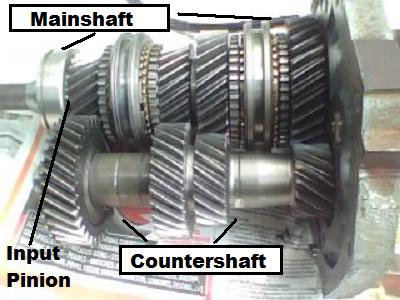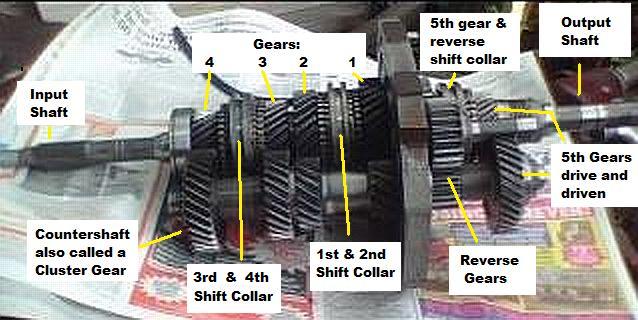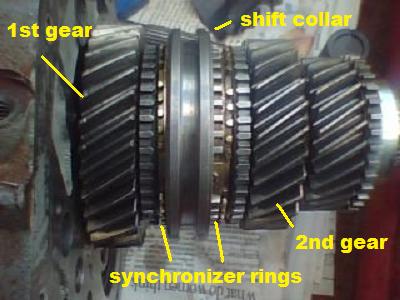
Auto and Truck Repair and Advice
Serving the Gainesville and Hawthorne Florida Area
Manual Transmissions and transaxles










Return to the Econofix Home Page
The gearshift lever moves shifter collars, which lock various gears to the output shaft. Then the input shaft turns the countershaft which turns the output shaft!
The input shaft is sometimes called the input pinion gear.
The gears in a synchronized transmission are all meshed and spinning together all the time. When you shift into a gear, a shift fork moves the shift collar, locking one gear at a time to the mainshaft (output shaft). The power goes from the input pinion to the countershaft to the locked gear on the mainshaft (output shaft).
One gear is always a direct drive, where the input shaft is linked directly to the output shaft: a 1 to 1 gear ratio. In the above transmission this is 4th gear: the "gear" labeled 4th is really the backside of the pinion gear which drives the countershaft. You could put a transmission together leaving the countershaft out and the transmission would still have this one "4th gear": a 1 to 1 direct drive. That, and 5 neutrals!
For this reason a failing transmission will often "get quiet" in 4th gear, and be really noisy in 5th, and often 1st through 3rd. In all other gears the force goes down form the input pinion to the countershaft, and then back up to the mainshaft. This creates opposite forces on the bearings. In the gear that's a direct drive (4th on the above tranny) this side force isn't there, so the transmission will "get quiet" in that gear.
An overdrive transmisssion has a top gear where the output shaft turns FASTER than the input shaft. This gets better fuel economy at highway speeds, but it "works" the transmission really hard, especially since 5th gear is usually smaller and lighter duty than the rest. On most overdrive transmissions, 5th gear is the first to go. Big trucks and commercial vehicles usually don't have overdrive transmissions.
WARNING!!!
Often a quick change oil place will SAY they check all your fuids, BUT THEY DON'T!!!
Modern manual transmissions use thinner oil than they used to, often using 30 wt motor oil or even automatic transmission fluid instead of the old standby, 90 wt gear oil. They do this mostly to increase fuel economy.
This thinner oil will leak out easier than 90 wt, and will leave less evidence of leakage. The transmission overhaul pictured above had 150,000 miles on it, looked clean from the outside, but didn't have a drop of oil in it. The roaring bearings and no 5th gear prompted the customer to check it out. She had gotten her oil changed at the Jiffy place every 3000 miles for the past 5 years. I'd say someone didn't check the fluid levels as advertised!!!
High mileage transmissions eventually use up the lifespan of either the bearings or the synchronizers. Bad bearings will make a rumbling sound. Bad synchros will make a grinding going into gear, or sometimes will "pop out" of gear going down the road.Manual Transmissions and Transaxles
Manual transmissions and transaxles are more poular today than in the recent past. One concern is fuel economy: manuals get slightly better fuel economy than automatics. Many people prefer a manual where THEY shift the thing when THEY want to!
HOW THEY WORK:
A clutch connects the engine flywheel to the transmission input shaft. The input shaft spins on one end of the output shaft. They share the same axis, but they are not connected. The input shaft spins the countershaft, which is below or beside the input and output shafts.
The countershaft is sometimes called the cluster gear.
The output shaft is sometimes called the mainshaft.

SYNCHRONIZERS
Synchronizers are brass (usually) rings inside the shifter collars. As the shifter moves the collar towards the gear, the brass ring in the collar rubs/slips against a steel cone, which it is being pressed into. This speeds the gear up or slows it down so the collar speed matches the speed of the gear, making the gear lock in smoothly. You can hear the gear spin up by downshifting at a fairly high speed with the clutch mashed in: you'll hear a "whirring" sound.
Overdrive Transmissions
Many 5 speed transmissions have 5th gear as an "overdrive". A non-overdrive transmission has a certain number of gears, and the top gear is a "Lockup" where the transmission is effectively "out of the picture" and operating at a 1 to 1 ratio. This "lockup" mode is very easy on the trasmission: it's not doing anything.
HOW MANUAL TRANSMISSIONS FAIL
As long as you keep oil in them, manual gearboxes last a long time. Seals fail and leak out the oil: that's when the trans goes bad.
>> CLICK HERE: The Econofix Cyber Mall!!! >

HELP SUPPORT THIS WEBSITE!